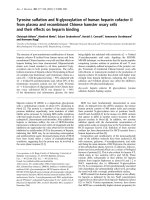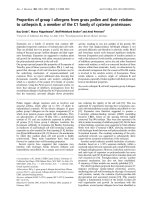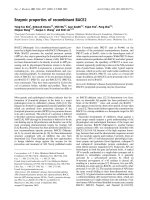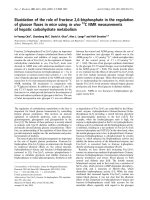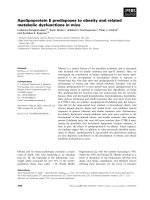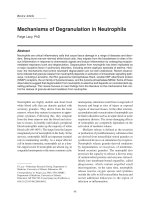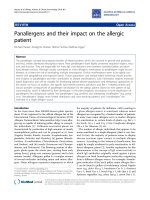Báo cáo y học: "Mice get their annual check-up" pdf
Bạn đang xem bản rút gọn của tài liệu. Xem và tải ngay bản đầy đủ của tài liệu tại đây (52.96 KB, 2 trang )
Genome Biology 2004, 5:358
comment
reviews
reports
deposited research
interactions
information
refereed research
Meeting report
Mice get their annual check-up
Virginia E Papaioannou
Address: Department of Genetics and Development, College of Physicians and Surgeons of Columbia University, 701 W. 168th St, New York,
NY 10032, USA. E-mail:
Published: 16 November 2004
Genome Biology 2004, 5:358
The electronic version of this article is the complete one and can be
found online at />© 2004 BioMed Central Ltd
A report on the 2004 meeting on Mouse Molecular
Genetics, Cold Spring Harbor, USA, 1-5 September 2004.
The annual meeting on mouse molecular genetics, which
alternates between Cold Spring Harbor and the European
Molecular Biology Laboratory (EMBL) in Heidelberg, is the
highlight of the meetings year for many mouse geneticists. It
encompasses a wide spectrum of topics in mouse develop-
ment and genetics and rewards participants with entertain-
ing talks in areas they might not be following closely.
The Smads have it
The keynote address, the Rosa Beddington Lecture in honor
of our late colleague, was delivered by Elizabeth Robertson
(University of Oxford, UK). Her talk on Smad proteins, the
downstream effectors of transforming growth factor beta
(TGFβ) signaling, set the tone for the meeting, which this
year had a decidedly developmental slant. Robertson
reported a series of studies that used genetic manipulation to
test the interrelationship of Smad proteins in regulating pat-
terning in the early mouse embryo. Genetic studies had
shown an interaction between Smad2 and Smad3 in down-
regulating the pathway stimulated by the growth factor
Nodal, indicating a functional redundancy between these two
Smads. But this idea challenged the conventional wisdom
based on differences in the biochemical activity of the pro-
teins - that is, until it was discovered that alternative splicing
of Smad2 produces a minor transcript that is 95% identical to
that for Smad3. To test experimentally whether this tran-
script could function like Smad3, Robertson removed an exon
from the Smad2 locus to make a mouse that expressed only
the short form. The mice were indeed normal, even in the
absence of Smad3. A clever genetic swap - putting the human
Smad3 gene into the mouse Smad2 locus while at the same
time knocking out the Smad2 locus - showed that Smad3
adequately transduces Nodal signaling, indicating that
Smad2 and Smad3 are functionally interchangeable. Finally,
a knockout of Smad4, which acts as a cofactor for receptor-
regulated Smads, revealed that only anterior patterning of the
early embryo was affected, indicating a dedicated function for
Smad4 in specifying the anterior region.
Patterning the early embryo from head to toe
In the session on embryonic patterning, several talks
addressed anterior-posterior (A-P) axis formation in the
pregastrulation-stage embryo, which consists of an inner
layer of epiblast and an outer layer of visceral endoderm.
The epiblast will form the entire body of the embryo following
gastrulation, whereas the visceral endoderm will make
extraembryonic membranes and also has a role in signaling
positional information to the anterior epiblast. It is well
known that the pregastrulation and early postgastrulation
embryo, the ‘egg cylinder’, is flattened, and that after primi-
tive-streak formation, this flattening coincides with the A-P
axis. So it was natural to assume that the prestreak flattening
coincided with the poststreak flattening, and thus also
represented an early indicator of the A-P axis. Anterior and
posterior molecular markers tell a different story, however.
These markers indicate that the A-P axis is aligned with the
short axis of the flattened cylinder in the pregastrulation
embryo, not the long axis, and apparently shifts to the long
axis as the primitive streak forms. How does this happen?
Does the gene-expression pattern shift? Do cells migrate? Or
does the egg cylinder change its shape?
Jérôme Collignon (Institut Jacques Monod, Université Paris
VI, France) reported lineage-tracing studies that support the
idea of a dramatic remodeling of the whole epiblast during
the specific prestreak-to-poststreak transition as a mecha-
nism for the shift in the A-P axis from the morphological
short axis to the morphological long axis of the cylinder. He
showed some mind-bending three-dimensional reconstruc-
tions of embryos made with wide-field optical coherence
tomography that back up this idea. The tantalizing conclusion
from these images is that there is a dramatic change in shape
of the embryo associated with the formation of a twist in the
proamniotic cavity at the level of the boundary between
embryonic and extraembryonic tissues. I, for one, am
anxious to see how this twist is resolved.
And what might control this embryo shape change? Jeff
Barrow (Brigham Young University, Salt Lake City, USA)
supplied evidence for a candidate gene, Wnt3, that might
play an important part. Wnt3 is normally expressed in both
the epiblast and the visceral endoderm in the posterior part
of the embryo. Null mutant embryos fail to gastrulate and
show a lack of posterior markers. Barrow used a conditional
Wnt3 allele and also chimeric analysis to show that it is the
epiblast expression of Wnt3, and not the visceral endoderm
expression, that is necessary for posterior identity and for-
mation of mesoderm. Of interest to the control of A-P axis
formation, he also observed that in Wnt3 mutant embryos,
the A-P axis is oriented along the short axis of the egg cylin-
der and apparently never shifts to the long axis. Could Wnt3
be a causative factor for the shift?
Coming to your senses
Have you ever wondered why after you brush your teeth with
menthol toothpaste even tepid water seems really cool? Or
how certain odors elicit powerful memories and responses?
Two entertaining and highly informative presentations in
the Neurobiology session had everyone nodding in recogni-
tion of these phenomena. Linda Buck (Fred Hutchinson
Cancer Research Center, Seattle, USA) chaired the session
and also gave a talk on odorant receptors (ORs) in the nasal
epithelium (in October, Buck, together with Richard Axel,
was awarded the Nobel Prize in Physiology or Medicine for
her work on these receptors).
About a thousand different ORs are expressed in the olfac-
tory sensory neurons. Each neuron expresses a single OR
and the receptors are used repeatedly and combinatorially,
such that each odor has a distinctive OR code. But with bil-
lions of possible codes, how do we discriminate odors? Buck
described the use of a transgenic tracer to investigate the
spatial input of nasal epithelial cells to the olfactory bulb and
the cortex. Although neurons with the same OR are scattered
around in the nose, they converge on specific locations in the
olfactory bulb, on a few glomeruli. In turn, inputs from one
OR are targeted to clusters of neurons at specific sites in the
olfactory cortex, creating a stereotypic spatial map that is
not related to that in the bulb. This means that single cortical
neurons may receive combinatorial inputs from many differ-
ent ORs, resulting in a stereotypic sensory map. Using c-Fos
expression as an indicator of neuronal activation, Buck has
found that different odorants elicit different but partially
overlapping activation patterns in the cortex and that the
representation of each odorant is composed of a small subset
of sparsely distributed neurons.
Ardem Patapoutian (The Scripps Research Institute, La
Jolla, USA) described the mechanisms of temperature sensa-
tion in relation to a family of genes encoding thermosensi-
tive ion channels that have been uncovered in the past four
years. These temperature-activated transient receptor
potential (TRP) ion channels, or thermo-TRPs, are differen-
tially expressed in a subset of dorsal root ganglia neurons
and some are specialized to detect distinct temperature
ranges - for example, there are cool channels and hot chan-
nels. In addition, they also respond to certain non-thermal
agonists such as chemical compounds. In what Patapoutian
described as a “drugstore experiment”, he combed the drug-
store shelves inspecting lists of ingredients of toothpaste,
gum and mouthwash, looking for compounds that activate
these ion channels. Compounds such as ‘hot’ cinnamon or
capsaicin (the heat in hot chili peppers) and ‘cool’ menthol
activate the channels and can be used to study temperature
sensation mediated by the different thermo-TRPs. Previous
work has identified some family members that respond to
different temperatures and others that sense a noxious tem-
perature, whether it is hot or cold. There are also thermo-
TRPs that are activated within the innocuous temperature
range of 34-42°C.
Patapoutian reported new studies on mice mutant for Trpv3,
a warm-sensitive ion channel that is activated at 33°C.
Because the commonly used hot-plate test does not cover
this temperature range, Patapoutian devised a hot plate with
a difference: one half was a warm 35°C and the other was
cooler, at room temperature. Normal mice prefer the
warmer temperature and spend more time on that side of
the hot plate, whereas mutants for Trpv3 have no preference
and spend equal time on either side, a nice demonstration
that this ion-channel gene affects the sensing of warm tem-
perature in vivo. It seems pretty obvious that temperature
sensation within this range, as well as within the range of
noxious temperatures, could have a selective advantage.
Interestingly, Drosophila larvae have temperature prefer-
ences and will avoid a heated area; knockout of TrpA genes
in Drosophila leads to loss of this avoidance behavior.
So why does menthol toothpaste make a drink of tepid water
seem colder? The presence of menthol shifts the activation
temperature of Trpm8 receptors to warmer temperatures,
thus boosting the cooling effect and confounding the percep-
tion of absolute temperature. Like so much of the research at
the conference, this rates as pretty cool.
358.2 Genome Biology 2004, Volume 5, Issue 12, Article 358 Papaioannou />Genome Biology 2004, 5:358

